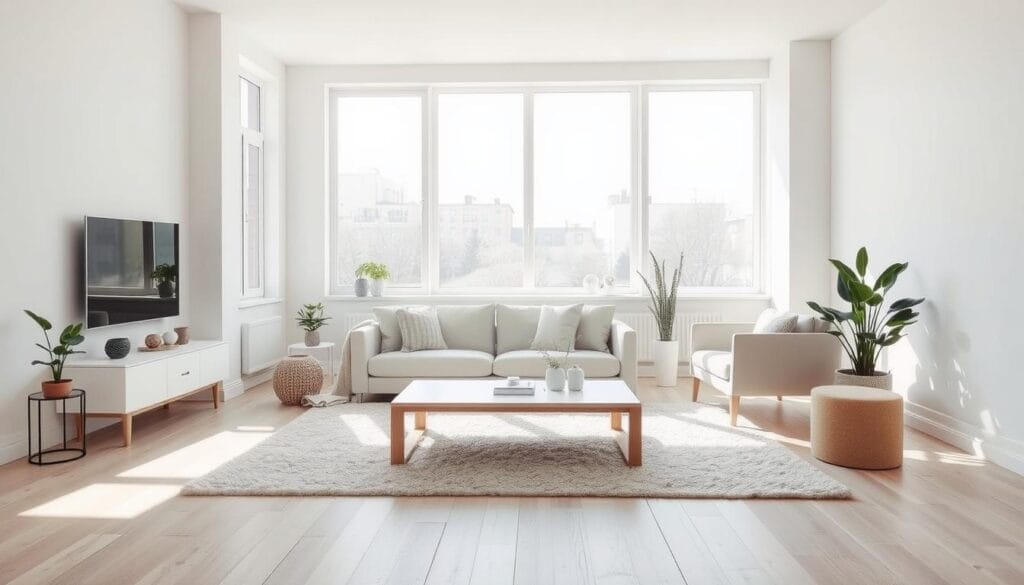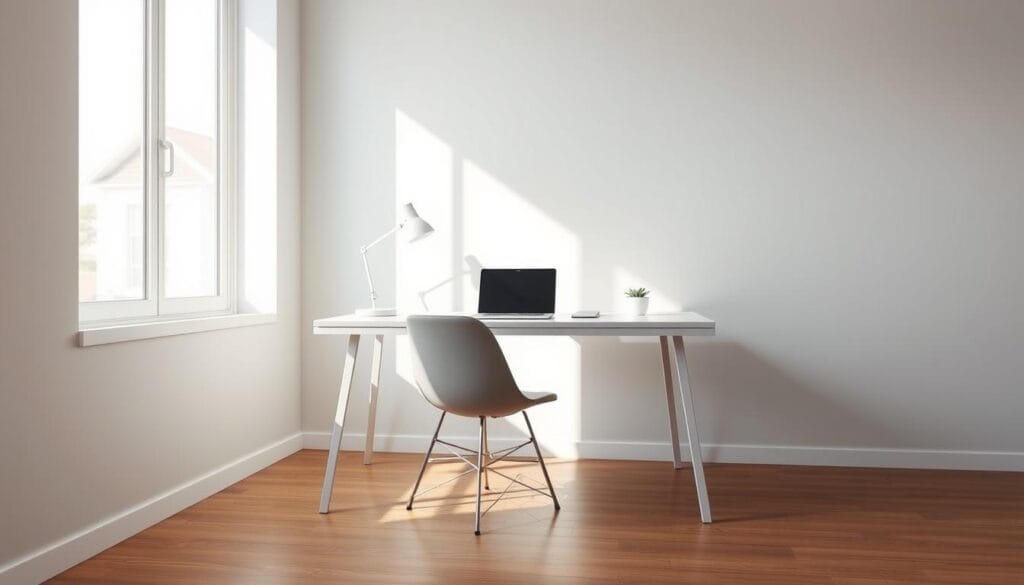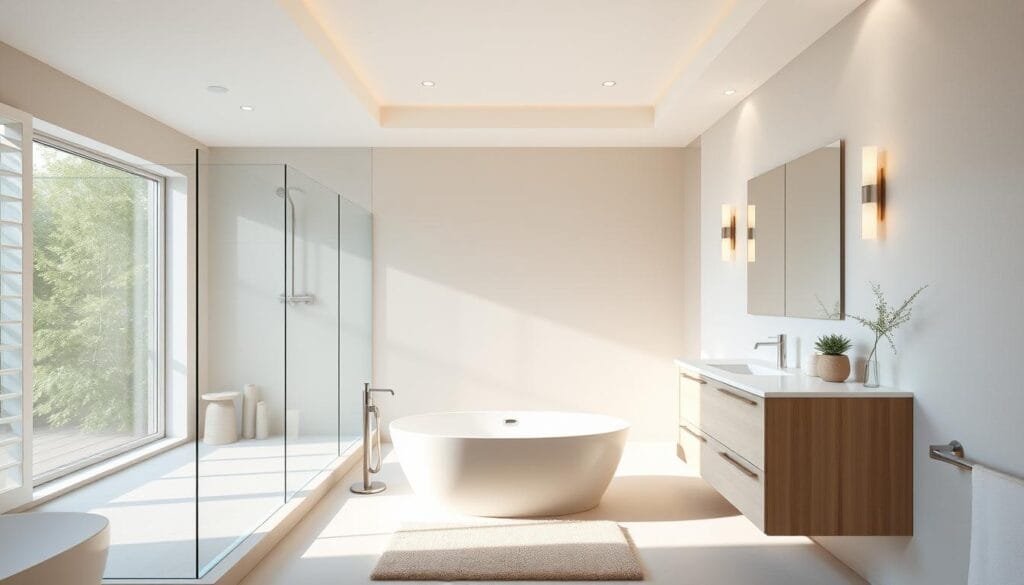The “Less is Best” idea is not just a passing trend—it’s a way of life that’s catching on fast. A few years back, I was buried under too many decor pieces and furniture. It was too much to handle. That’s when I learned about minimalist design, and it changed my life.
Picture entering a room where everything has its spot, surrounded by light and simplicity. Feels calming, right? When I chose minimalism for my home, it turned into a peaceful haven. No more clutter chaos. And it turns out, I’m not alone. Studies suggest that minimalist homes are seen as nicer and less messy. This brings peace and boosts our mood.
Let’s start our minimalist journey together. We’re going to learn how to tidy up, pick the best furniture, and choose soothing colors. Embrace the simple life and make a home that’s truly minimalist. So, let’s get started with our coffee in hand on this journey to simplistic living!
Looking for more ways to use your space wisely? Then check out this guide to maximizing space in a small living room.
Understanding Minimalist Home Design
Minimalist home design is more than just looks—it’s a way of living simply and with purpose. It’s been influenced by Japanese architecture and designs from the mid-1900s. These styles value clean lines and open spaces where everything has a reason to be there.
Choosing a minimalist style helps the planet and cuts down on too much stuff. It makes homes cheaper to keep up and less stressful. Living with less clutter can make you feel better, both mentally and physically, leading to a calmer home.
Minimalist design has become more popular lately, with people like Marie Kondo and Kim Kardashian showing it off. Homes like this usually have soft colors that make the space feel calm and big. Homeowners learn to pick out a few high-quality things, which makes their homes last longer and feel more special.
If you want to try minimalist design, pick everything with care. Each item should add to the room’s feel. Using open floor plans helps light flow better and connects the space smoothly.
For a deeper look at minimalist design, check out Architectural Digest. They have a great guide you can read here. It’s full of tips on making your home simple yet stunning.
Learning about the history and idea of minimalist living can help you make smart choices for your home. This style is about more than less clutter. It supports living a life that values less waste and more happiness.
Key Principles of Minimalist Design
In minimalist design, simplicity and functionality are key. Every item in the space has a clear purpose. This gets rid of unnecessary decor. It makes home design clear and efficient, with each piece both useful and appealing.
One beautiful part of minimalist interiors is how they use light and space. They aim to make the most of natural light. By using big windows and shiny surfaces, rooms look brighter and bigger. This makes spaces feel open and brings a peaceful vibe.
Minimalist spaces love simplicity and functionality. They often have open floor plans for a neat and tidy look. Cutting down on clutter is a big focus. They use lots of hidden storage to keep things tidy and save space by up to 20%.
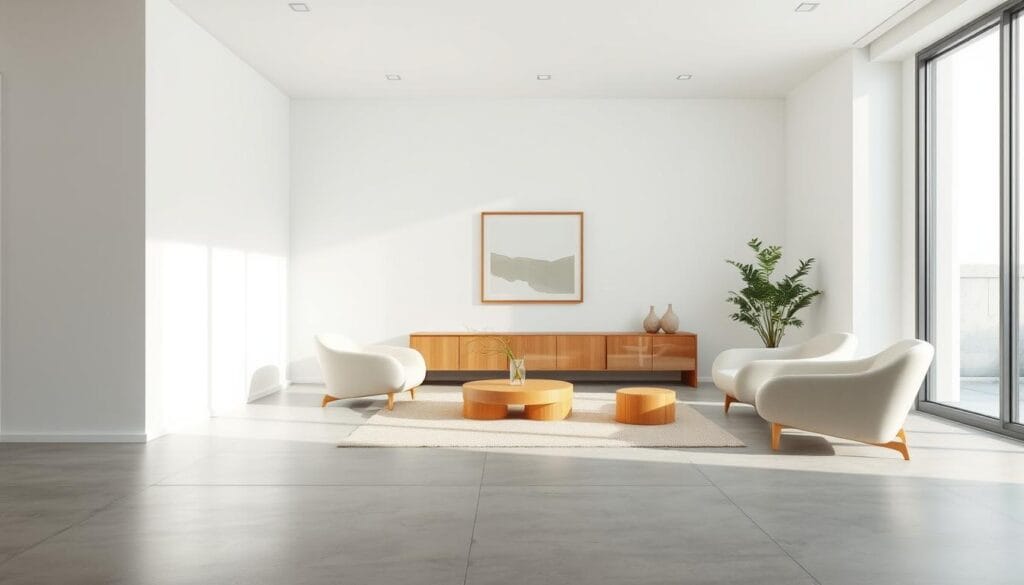
The idea “Less is More,” by architect Ludwig Mies van der Rohe, is at the heart of minimalist design. It’s about being functional and simple. Minimalist design favors natural materials like wood and metal. These choices are also good for the planet.
In minimalist spaces, white is common but not the only choice. Different shades and textures add coziness. A dash of bold color or a simple texture can add character. Instead of patterns, solid colors help make a place feel calm and soothing.
Minimalist design aims to create a balance with shape, light, and materials. It seeks to make your home feel open, warm, and a true reflection of “less is more.”
Choosing a Minimalist Color Palette
Picking the right colors is key in minimalist home design. Neutral tones like white, beige, and gray create a peaceful feeling. Did you know 90% of minimalist designs mainly use white to make spaces look clear and big? Colors like White Heron OC-57 and Chantilly Lace OC-65 are loved by 65% of homeowners for their soothing effect.
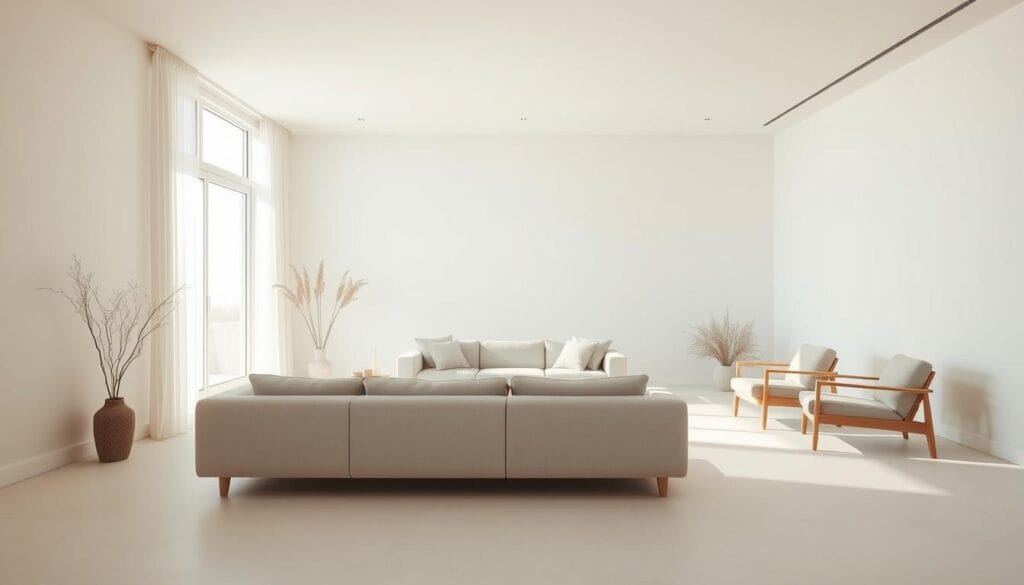
Neutral tones are central to minimalist design, but adding creams like Maritime White OC-5 and Ballet White OC-9 adds warmth. This is true for 55% of minimalist spaces. Another 40% use greige tones like Revere Pewter HC-172 and Edgecomb Gray HC-173, which make rooms feel bigger and more peaceful by reflecting light.
It’s not just about neutral tones, though. For a pop of color without losing calm, accent colors are perfect. About 30% of minimalist designs use colors like Rosy Apple 2006-30 and Iron Mountain 2134-30 to highlight features. In minimalist kitchens, 25% mix black and white, like Cloud Cover OC-25 and Black Tar 2126-10, for a striking look.
Adding bold colors and different sheens brings depth and personality. Fifteen percent use satin finishes on walls and ultra-flat on ceilings. Surprisingly, 10% are trying dark colors like royal purples and deep blues instead of traditional black. These choices make a minimalist space feel dynamic and unique.
A well-picked minimalist color scheme, with its neutral tones and smart accent colors, turns any area into a calm and stylish retreat.
Furniture Selection for Minimalist Spaces
Trust me, the right furniture can really enhance a minimalist home design. The main goal is to keep things simple yet functional. That’s why Multi-functional Furniture is perfect. It adjusts to your needs, saves space, and keeps things tidy.

Picking quality over quantity is key. Avoid filling your space with many cheap items. Instead, choose a few high-quality pieces. They’re durable, beautiful, and a smart investment for a stylish and eco-friendly home.
Here are some smart furniture choices for a minimalist space:
| Furniture Piece | Feature | Benefit |
|---|---|---|
| Double-duty storage bed | Built-in storage compartments | Maximizes bedroom space |
| Loveseat | Compact yet comfortable | Reduces visual clutter |
| Minimalist coffee table | Straight edges, quality material | Durable, visually appealing |
| Ottoman | Versatile and portable | Multi-purpose use |
Choosing Multi-functional Furniture means you value a minimalist look and sustainable living. Each item should be useful, making your home both practical and peaceful. With fewer items, cleaning and organizing are much easier.
If you’re into minimalism or just starting out, remember that quality, functionality, and simplicity are key. They help you create a beautiful, clutter-free home. 🌿
Decluttering Your Home
Starting to declutter your home is a big step towards a simpler lifestyle. We often keep items we think we need, but they just add clutter. Removing these items can make your home look better and feel more functional.
- Identifying Necessities: Start by looking at what you have. Keep only what you really need or love. This helps reduce clutter.
- Regular Reviews: Check your items often to keep your home clutter-free. This way, you only have what you need.
- Smart Storage Solutions: Use clever storage to stay tidy. Choose furniture that has more than one use and hidden storage to save space.
- Resist Accumulation: Try not to buy things you don’t need. Before buying something new, ask if it’s essential or just a quick want.
Decluttering not only removes clutter but also improves your mental health. Studies show that messy homes raise stress levels. Following minimalism, which means having fewer things, can make you feel calmer and happier.
To keep your space tidy, use the 4-box method. Sort things into Donate/Sell, Garbage, Recycling, and Bring Home boxes. For items you’re unsure about, place them in a “penalty box” and decide their fate after 1, 3, or 6 months.
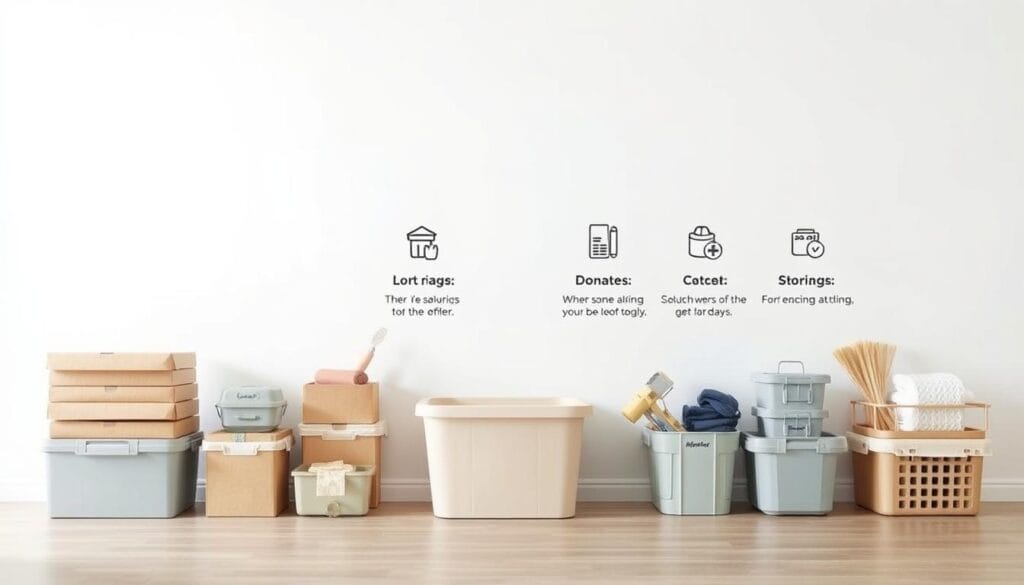
By following these decluttering steps, your home can become a peaceful place. The beauty of minimalism is not just how it looks but also how easy and pleasant it makes life. Enjoy decluttering!
Incorporating Natural Elements
Bringing nature into your home is more than just pretty—it’s good for you and the planet. Adding plants can turn a simple space into a peaceful oasis. Indoor plants like succulents clean the air. They also boost your work and creativity, making you 15% more productive.
Think about using wood, stone, and metal. These materials make your home feel grounded and calm. Choosing items that are sustainably made shows you care about the earth.
Earthy colors help create a relaxed setting. Beige, brown, green, and white are perfect. They make spaces bright and open.
Textiles are important too. Use natural fabrics like cotton or linen for a cozy vibe. Items made by hand add personality to your space.
Choose lights that are good for the planet. Think bamboo or LED lights. Big windows and sliding doors can mix indoor and outdoor living.
Using nature in your design makes your home healthy and energy-saving. Every step towards using plants and sustainable materials makes your home more peaceful and lovely.

